Tırmanma terimleri
Bu sayfada tırmanma konusunda sık karşılaşılan sözcükler, kavramlar, ve kavramlaşmış ticari ürün isimleri olabildiğince bir de
resmiyle, kısaca tanıtılır. Kendi sayfası varsa link verilir.[1]
| Resmi | Türkçesi | Türkçe açıklama | İngilizcesi | İngilizce açıklama | |
|---|---|---|---|---|---|
 |
Abalakov thread | A type of abseiling point used especially in winter and ice climbing. Also known as V-thread. | |||
 |
Ablation zone | The area of a glacier where yearly melting meets or exceeds the annual snow fall. | |||
 |
İp boyu iniş | Tırmanıcının sabit ip ile gerçekleştirdiği iniş süreci | Abseil | The process by which a climber can descend a fixed rope. Also known as Rappel. | |
 |
ACR (Alpine Cock Ring) | An anchor method similar to a cordelette but that is dynamically equalizing. It employs a cord and a rappel ring. | |||
 |
Keser ağzı | Buz baltasının sapına dik kesici ağzı olan ve ayağın basıp tutunabileceği yer kazmaya yarayan balta dili. | Adze | A thin blade mounted perpendicular to the handle on an ice axe that can be used for chopping footholds. | |
 |
Önceden yerleştirilmiş koruyucu veya yardımcı alet edavata bağlanarak sağlama alma veya tutunarak kendini yukarı çekme temelli tırmanma usulü. | Aid climbing | A style of climbing in which standing on or pulling oneself up via devices attached to fixed or placed protection is used to make upward progress. | ||
 |
Geleneksel dağa tırmanma; yüksek ihtimalle biraz buz, biraz kuru kaya içeren güzrgahlarda, gereken her şeyi üzerinde taşıyarak, bazen gecelemeli tırmanma usulü. | Alpine climbing | Generally climbing in the mountains. Probably includes a mixture of ice climbing and dry-tooling. Alpine style generally means carrying all gear in a backpack even for multi day climbs. | ||
 |
diz üstü | Alpine knee | To use your knee as a way to gain ground on a climb. | ||
 |
Akşamdan her şeyi hazır edip sabah erken güneş doğmadan tırmanmak için yola çıkmak. | Alpine start | To make an efficient start on a long climb by packing all your gear the previous evening and starting early in the morning, usually well before sunrise. | ||
 |
Yükseklik/İrtifa hastalığı | Altitude sickness | A medical condition that is often observed at high altitudes. Also known as Acute mountain sickness, or AMS.Cymerman, A; Rock, PB. Medical Problems in High Mountain Environments. A Handbook for Medical Officers. USARIEM-TN94-2. US Army Research Inst. of Environmental Medicine Thermal and Mountain Medicine Division Technical Report. http://archive.rubicon-foundation.org/7976. Erişim tarihi: 2009-03-05. | ||
 |
Amerikan ölüm üçgeni | İp halkasını iki nokta arasına asıp daha sonra tırmanma (ya da iniş) ipini halkanın sadece bir kenarına tutturmak. Bu durumda tırmanma ipine yük bindiğinde halka bir üçgen oluşturur ve tutunma noktalarına gereksizce büyük kuvvetler yükler ve tepeye tutunma düzeneğinin güvenilirliğini azaltır, tehlikelidir. | American death triangle | An anchor which is created by connecting a closed loop of cord or webbing between two points of protection, and then suspending the rope from a carabiner clipped to only one strand of said anchor. This creates a triangular shape in the webbing or cord, which places massively multiplied inward forces on the protection, making it a dangerous, ineffective anchor. | |
 |
Anchor | An arrangement of one or (usually) more pieces of gear set up to support the weight of a belay or top rope. | |||
 |
Asıl tırmanmanın başlayacağı noktaya yaklaşma güzegahı; sadece yürüyüş gerektirse bile genellikle tırmanmanın kendisi kadar tehlikeli olabilir. | Approach | The path or route to the start of a technical climb. Although this is generally a walk or, at most, a scramble it is occasionally as hazardous as the climb itself. | ||
 |
Basamak, tutanak, |
|
Arête |
| |
 |
Kolu çatlağa kilitlemek | Dar kaya çatlağına tutunma yöntemi. | Arm bar | Jamming an arm into a crack and locking it into place. | |
 |
parmak ucuyla tutunmak | Parmakların ilk eklemleri açık ve çok gergin, son eklemleri 90 derece bükük şekilde tutunmak. Bu yöntem kasları parmağa bağlayan tendonlara fazla kuvvet ve yumuşak parmak uçlarına çok basınç yükler, ve çok kullanıldığında zedelenmelere, sakatlıklara sebep olmasıyla bilinir. | Arqué | (from the French word meaning arched) Used to describe crimping. In this position typically the first set of knuckles are hyperextended and the second have a sharp angle of about 90 degrees. This combines muscular effort with soft tissue tensions in order to apply the load. When used often, this position has been known to over-stress the tendons in fingers and lead to injuries. | |
 |
ipte (alet yardımıyla) yükselme | Ascend | To climb a rope using aid device. | ||
 |
yükseltici | İpi tutmaya yarayan, kendini çektikten sonra kolayca ip boyu yeri değiştirilebilen alet | Ascender | A device for ascending on a rope. | |
 |
yamaç yönü | Aspect | The direction in which a slope faces.Aspect (geography) | ||
 |
ATC | Black Diamond firmasının kontrollü indirme cihazı adının alet çeşidi adı olmuş hali (ATC aslında Hava trafik kontrolü yani havaalanı kulesindekilerin yaptığı işin adı idi) | ATC | A proprietary belay device manufactured by Black Diamond. Has become common term for any tubular belay devices. ATC originally stood for 'Air Traffic Controller'. | |
 |
Automatic belay | A fast method for setting up a two-point anchor in sport climbing, using the climbing rope to attach to the anchor points. | |||
 |
Tırmanıcının düşmesi durumunda ipin bacaklar arasında dolalı gerilip kemer yerine ipe yük bindirerek düşüşü durdurması. | Austrian floss | When a climber falls in a manner where the rope that they are attached to runs through their legs; upon falling, the rope tightens and suspends the climber via the rope rather than the harness. | ||
 |
John Gill adlı tırmanıcının buluşu tırmanma zorluğu ölçümü derecelemesinde bir değer. Şimdilerde daha çok "V" grading system kullanılır. | "B"-grade | A grading system for bouldering problems, invented by John Gill. Now largely superseded by the "V" grading system. | ||
 |
İç kasları luvvetlendiren idman aleti | Bachar ladder | A piece of training equipment used to improve campusing and core strength. | ||
 |
Liderli tırmanmada tehlikeli bir hata. Liderin emniyet ipi kaya yüzeyinde asılı bir karabinaya dıştan içeriye doğru yükselen yönde, dil altından geçirilmişse, Liderin düşme durumunda emniyet ipi karabinanın dili etrafında içerden dışarıya doğru dolanıp yüklenebilir, dil içeriye doğru açılabilir, ve ip karabinadan kurtulabilir. | Back-clipping | A potentially hazardous mistake that can be made while lead climbing. The rope is clipped into a quickdraw such that the leader's end runs underneath the quickdraw as opposed to over top of it. If the leader falls, the rope may fold directly over the gate causing it to open and release the rope from the carabiner. | ||
 |
Cayıp tırmanmadan geri dönme | Bail | To retreat from a climb. | ||
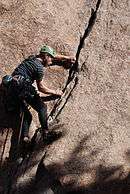 |
Bütün vücudun bir eksen etrafında ahır kapısı gibi kontrolsüz dönmesi | Barn-door | If all points of contact climber has with the wall are on a straight axis, or close to it, his body might swing uncontrollably downward around this axis, like a door on a hinge. | ||
 |
Bakır başlıklı çatlak kazığı | Bashie | A copperhead intended for pounding into a crack | ||
 |
Tırmananın düşmesi durumunda sürtünmeyle ÿavaşlatmak ve durdurmak temelli emniyet ipinin öbür ucundan kontrolü; bu amaçlı aletler den önce ip yardımcının kalçasına sarılır, sürtünme ile frenleme sağlanırdı. | Belay | To protect a roped climber from falling by passing the rope through, or around, any type of friction enhancing belay device. Before belay devices were invented, the rope was simply passed around the belayer's hips to create friction. | ||
 |
ip fireni(?) | Düşme durumunda sürtünmeyle frenlemek, ÿavaşlatmak ve durdurmaya yarayan mekanik alet.Bir çok çeşitleri vardır; ATC, grigri, Reverso, Sticht plate, sekizli ve tuber. Bir çoğu indirici olarak ta kullanılabilir. Bazen munter bağı da ip fireni olarak kullanılabilir. | Belay device | A mechanical device used to create friction when belaying by putting bends in the rope. Many types of belay devices exist, including ATC, grigri, Reverso, Sticht plate, eight and tuber. Some belay devices may also be used as descenders. A Munter hitch can sometimes be used instead of a belay device. | |
 |
ip fireni halkası | kemer ve koşum ¨zerindeki en kuvvetli halka. Oraya başka şeylerde bağlamak, eskitmek, iyi olmaz. | Belay Loop | The strongest point on the harness. This is the loop you use your belay device on. You should not tie anything around the belay loop such as a daisy chain or sling. The belay loop will wear more quickly. | |
 |
Frenin kaldırılması isteğinde cevaben Yardımcının ipte artık firen olmadığını tasdik eden doğrulayan sözleri. | Belay off | Called by belayer to confirm belay has been removed from climbing rope. Response to Off belay request. | ||
 |
Tırmanıcının yardımcıdan firenin ipten kaldırılması isteği | Belay on | Called by belayer to confirm belay has been (re)applied to climbing rope. Response to On belay request. | ||
 |
firen kölesi | Devamlı yardımcılık yaptırılan, hiç tırmanma faaliyetlerine katılamayan | Belay slave | Someone that volunteers for, or is tricked into, repeated belaying duties without partaking in any of the actual climbing. | |
 |
Plansız geceleme çadır veya sığınağı | Benightment: An unscheduled overnight bivouac often due to an epic. | |||
 |
Buzulda bir yarık tipi | Bergschrund (or schrund) | A crevasse that forms on the upper portion of a glacier where the moving section pulls away from the headwall. Also called a 'shrund. | ||
 |
Zor bir tırmanma güzergahını başarıyla tamamlamanın püf noktaları; bilindiğinde güzergahın
değer kaybettiğini düşünenler vardır. |
Beta | Advice on how to successfully complete (or protect) a particular climbing route, boulder problem, or crux sequence. Some climbers believe that beta 'taints' an ascent. | ||
 |
püf noktalarını duyup tırmanma güzergahını ilk denemede başarıyla tamamlama. | Beta flash | The clean ascent of a climb on the first attempt, having previously obtained beta or while having beta shouted up from the ground en route. Also see on-sight.
| ||
 |
ancak iki parmağın sığabileceği tutanak deliği | Bidoigt | (French "two fingers") A climbing hold, typically a pocket or hueco, that has enough room for two fingers. See also mono. | ||
 |
bir günde tırmanılamayacak dolayısıyla¨gecelemek için gerekli malzemelerinde tırmanılan ara noktalara torbalarla çıkarıldığı tırmanma güzergahı | Big wall | A climb on which most parties will spend more than one day. Big wall style generally refers to hauling the needed gear (food, water, sleeping bags) in a haulbag. Instead of carrying the gear on their person, the climbers put it in the haul bag and raise it in between pitches. | ||
 |
Biner : See Carabiner. | ||||
 |
Bivy (or bivvy) | From the French "bivouac". A camp, or the act of camping, overnight while still on a climbing route off the ground. May involve
nothing more than lying down or sitting on a rock ledge without any sleeping gear. When there is no rock ledge available, such as on a sheer vertical wall, a portaledge that hangs from anchors on the wall can be used. | |||
 |
Bivy-bag | A lightweight garment or sack offering full-body protection from wind and rain. | |||
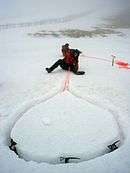 |
Bollard | A large knob of rock or ice used as a belay anchor. | |||
 |
Bolt | A point of protection permanently installed in a hole drilled into the rock, to which a metal hanger is attached, having a hole for
a carabiner or ring. | |||
 |
Bolt chopping | The deliberate and destructive removal of one or more bolts. | |||
 |
Bomb-proof anchor | A totally secure anchor. Also known as bomber. Bomber can also refer to a particularly solid handhold or foothold (a
"Bomber Jug") | |||
 |
Book or open book | An inside angle in the rock. See also dihedral. | |||
 |
Booty | Gear left behind at a climbing area. | |||
 |
Bosun's chair | To reduce pains from heavy-duty climbing using a harness; such as long-time belaying or bolting a new route, climbers attach their
harness with a special type of chair, which is usually light and has multiple high endurance straps and buckles. Similar types are also used in industrial climbing. | |||
 |
Bouldering | The practice of climbing on large boulders. Typically this is close to the ground, so protection takes the
form of crash pads and spotting instead of belay ropes. | |||
 |
Bridging | see Stemming | |||
 |
Bucket | A large handhold. | |||
 |
Bummer | A slang word, referring to a difficult or uncomfortable hold, often one that tears the skin on the hand. | |||
 |
Bump | A climbing technique wherein a hand or foot is moved to one hold then quickly moved up immediately to a further hold. This is often
done over short distances advancing from an inferior hold to a superior one. | |||
 |
Buildering | The art of climbing on buildings, which is often illegal. | |||
 |
Buttress | A prominent feature that juts out from a rock or mountain. | |||
 |
Cairn | A distinctive pile of stones placed to designate a summit or mark a trail, often above the treeline. | |||
 |
Cam | A spring-loaded device used as protection. | |||
 |
Camming | Motion or position where rotation of a piece of equipment or body part presses it tight against a rock, creating friction and
holding it in place. As in Spring-loaded camming device, Heel-Toe Cammming,Van Leuven, Chris (15 June 2012). "The Heel-Toe Cam". Climbing. http://www.climbing.com/skills/the-heel-toe-cam/. Erişim tarihi: 12 December 2016. or knee bar camming. | |||
 |
Campus | The act of climbing without using any feet. | |||
 |
Campus board | Training equipment used to build finger strength and strong arm lock-offs. | |||
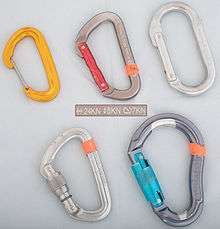 |
Karabina | Açıldığında kanca, kapandığında halka işlevi gören, bir çeşit köstek. Normalde halka olarak kullanılıp, sadece anlık ve geçici
olarak kanca olması, yaylı, kendiliğinden kapanan kapısıyla hızlı kullanım kolaylığı sağlaması, bir de kazaen açılmaya karşı tedbirleri varoluş sebebidir. |
Carabiner | Metal rings with spring-loaded gates, used as connectors. Usually oval or roughly D shaped. Also known as crab or biner
(pronounced kar-uh-bee-ner). | |
 |
Chalk | A compound used to improve grip by absorbing sweat. It is actually gymnastics chalk, usually [[magnesium
carbonate]]. Its use is controversial in some areas. | |||
 |
Chalk bag | A hand-sized holder for a climber's chalk that is usually carried on a chalkbelt for easy access during a climb.
| |||
| |
Chicken head | see bollard, horn.
on the other. | |||
 |
Chimney |
climber often uses his head, back and feet to apply opposite pressure on the vertical walls.
| |||
 |
Chipping | Improving a hold by permanently altering the rock, which is considered unethical and unacceptable. | |||
 |
Chock |
| |||
 |
Choss | Loose or "rotten" rock. | |||
 |
Classification | See Grade. | |||
 |
Clawing | Use of front points of crampons, ice axe pick and ice hammer pick to climb a slope. | |||
 |
Clean |
pitons or copperheads) into the rock (see protection). | |||
| |
Cleaning tool | A device for removing jammed equipment, especially nuts, from a route. Also known as a nut key or nut
tool. | |||
 |
Climbing area | A region that is plentiful with climbing routes. | |||
 |
Climbing command | A short phrase used for communication between a climber and a belayer. | |||
 |
Climbing gym | Specialized indoor climbing centres. See gym climbing. (Usually just called a 'climbing wall' in Britain). | |||
 |
Climbing shoe | Footwear designed specifically for climbing. Usually well fitting, with a rubber sole. | |||
 |
Climbing technique | Particular techniques, or moves, commonly applied in climbing. | |||
 |
Climbing wall | Artificial rock, typically in a climbing gym. | |||
 |
Clipping in | The process of attaching to belay lines or anchors for protection. | |||
 |
Clipstick | See Stick clip. | |||
 |
Col | A small pass or "saddle" between two peaks. Excellent for navigation as when standing on one it's always down in two, opposite,
directions and up in the two directions in between those. | |||
 |
Copperhead | A small nut with a head made of soft metal on a loop of wire. | |||
 |
Cord lock | a lock or toggle used to fasten cords with gloved hands. Used on most mountaineering gear. | |||
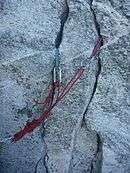 |
Cordelette | A long loop of accessory cord used to tie into multiple anchor points. | |||
 |
Corner | An inside corner of rock, the opposite to an arête (UK). See Dihedral. | |||
 |
Cornice | An overhanging edge of snow on a ridge. | |||
 |
Couloir | A steep gully or gorge frequently filled with snow or ice. | |||
 |
Crack climbing | To ascend on a rock face by wedging body parts into cracks, i.e. not face climbing. See jamming and | |||
 |
Crag | A small area with climbing routes, often just a small cliff face or a few boulders. | |||
 |
Crampons | Metal framework with spikes attached to boots to increase safety on snow and ice. | |||
 |
Cramponing |
distribution.
| |||
 |
Crank | To pull on a hold as hard as possible. | |||
 |
Crash pad | A thick mat used to soften landings or to cover hazardous objects in the event of a fall. See: Bouldering mat | |||
 |
Crater | Hitting the ground at the end of a fall instead of being caught by the rope. | |||
| |
Crimp |
| |||
 |
Crux | The most difficult portion of a climb. | |||
 |
Cup | A hand grip which is squeezed, over the top or around the side, between the fingers and palm, forming a cup shape with the hand, or
applying this type of hold on any protrusion or feature. More commonly known as guppy. | |||
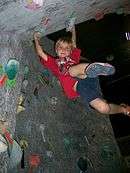 |
Cut-loose | Where a climber's feet swing away from the rock on overhanging terrain, leaving the climber hanging only by their hands. Also known
as "Cutting feet." | |||
 |
Cwm | (Welsh) A hanging valley, or cirque—a steep-walled semicircular basin in a mountain
—sometimes containing a lake; also known as a corrie. | |||
 |
Daisy chain | A special purpose type of sling with multiple sewn or tied loops, used in aid and big wall climbing. It is designed to
hold a climber's bodyweight, rather than arrest a fall, and while the sling as a whole will have a strength rating comparable to that of a standard sling, the individual loops will typically have much lower ratings. | |||
 |
Dead Ball | Type of High Ball boulder, where one can possibly die when falling from above. | |||
 |
Dead hang | To hang limp, such that weight is held by ligament tension rather than muscles. | |||
 |
Deadman anchor | An object buried into snow to serve as an anchor for an attached rope. One common type of such an anchor is the snow fluke. Any object that is buried in order to make an anchor, or what you become if that anchor fails. | |||
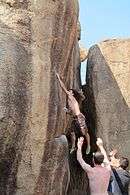 |
Deadpoint | A dynamic climbing technique in which the hold is grabbed at the apex of upward motion. This technique places minimal strain on
both the hold and the arms. | |||
 |
Deck |
| |||
 |
Deep Water Soloing | Free climbing an area that overhangs a deep enough body of water to allow for a safe fall. Often abbreviated DWS. | |||
 |
Sekizli | metalden sekiz rakamına benzer şekilli, sürtünme ile yardımcının yol katedildiğinde ip sugalamasını, düşme durumunda ise durdurmasını kolaylaştıran alet. | Descender | A device for controlled descent on a rope. Also called a rappel device. Many belay devices may be used as descenders, including
ATCs, figure eights, or even carabiners. See rappel. | |
 |
Desmond | A ground fall (from Desmond Dekker, a reggae artist and 'to deck'). | |||
 |
Dexamethasone | A pharmaceutical drug used in the treatment of high altitude cerebral edema as well as high altitude pulmonary edema. It
is commonly carried on mountain climbing expeditions to help climbers deal with altitude sickness. Also known as "dex". | |||
 |
Dialled | To have complete understanding of a particular climbing move or route. | |||
 |
Diamox | A drug used to inhibit the onset of altitude sickness. Otherwise known as acetazolamide. | |||
 |
Dièdre | A dihedral. | |||
 |
Dihedral | An inside corner of rock, with more than a 90-degree angle between the faces. See also corner and arête. | |||
 |
Direct aid | A type of tension climbing consisting of using one or more belay ropes to haul the leader up to the next point of protection. | |||
 |
Dirtbag | climbers living cheaply and supporting themselves through odd jobs in order to maximize the amount of time climbing. Well known
practitioners of this lifestyle include Jan and Herb Conn or Fred Beckey. | |||
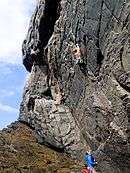 |
Double Ropes or Half Ropes | System where the climber is using two thin ropes instead of one thicker one. Double ropes are often used by trad and
alpine climbers. They help managing the rope drag, reduce the chances for accidental cutting of the rope by sharp rock edges, and allows full pitch repelling. Unlike twin ropes, double ropes can be clipped separately into different pieces.Davis, Steph (25 April 2011). [http://stephdavis.co/blog/straight-from-the-mammoths-mouth-half-ropes-are-not-twins/ "Straight From the Mammoth’s Mouth: Half Ropes Are Not Twins |
Steph Davis - High Places"]. http://stephdavis.co/blog/straight-from-the-mammoths-mouth-half-ropes-are-not-twins/. Erişim tarihi: 9 December 2016. | ||
 |
Double Rope Technique (DRT) | The term denotes the use of double ropes. | |||
 |
Doubled Rope Technique (DdRT) | A method used primarily by tree climbers where the rope passes over a support/limb and continuously slides over the limb as the
climber ascends or descends. | |||
 |
Downclimb | To descend by climbing downward, typically after completing a climb. | |||
 |
Drop Knee | See Egyptian. | |||
 |
Drag or rope drag | Rope drag occurs when the friction generated from the rope running over the rock and through the quickdraws builds up to the
point where it is difficult move or to pull up the rope to clip into protection. There are several ways to prevent rope drag: protection placement that minimizes zig-zaging of the rope and potential for rope being pinched or hooked on a rock, use of long quickdraws like 24 inch alpine draws and use of double ropes.Ellison, Julie (11 January 2013). "Extension Basics". Climbing. http://www.climbing.com/skills/extension-basics/. Erişim tarihi: 9 December 2016."Preventing Rope Drag". http://www.climbingtechniques.org/preventing-rope-drag.html. Erişim tarihi: 9 December 2016. | |||
 |
Dry-tooling | Using tools for ice climbing like crampons and ice axes on rock. | |||
 |
Dülfersitz | A method of rappelling, without mechanical tools, where the uphill rope is straddled by the climber then looped around a
hip, across the chest, over the opposite (weak) shoulder, and held with the downhill (strong) hand to adjust the shoulder friction and thus the descending speed. | |||
 |
Dynamic belay | Technique of stopping a long fall using smooth braking to reduce stress on the protection points and avoid unnecessary trauma from
an abrupt stop. | |||
 |
Dynamic rope | A slightly elastic rope that softens falls to some extent. Also tend to be damaged less severely by heavy loads. Compare with | |||
 |
Dynamic motion | Any move in which body momentum is used to progress. As opposed to static technique where three-point suspension and slow,
controlled movement is the rule. | |||
 |
Dynamite starfish | Tightly gripping handholds, simultaneously flagging out both legs then proceeding to violently kick downwards and inwards in a
desperate attempt to produce upwards motion; making the climber resemble an explosive bottom feeder . | |||
| |
Dyno | A dynamic move to grab a hold that would otherwise be out of reach. Generally both feet will leave the rock face and return again
once the target hold is caught. Non-climbers would call it a jump or a leap. | |||
 |
Edge | A thin ledge on the rock. | |||
 |
Edging | Using the edge of the climbing shoe on a foothold. In the absence of footholds, smearing is used. | |||
| |
Egyptian | Method for reducing muscle strain in arms when holding a side grip. One knee ends up in a lower position with the body twisted
towards the other leg. It can give a longer reach as the body and shoulders twist towards a hold. Also known as a "drop knee." | |||
 |
Egyptian bridging | The same position as bridging or chimneying, but with one leg in front and one behind the body. | |||
 |
Eight-thousander | A mountain whose elevation exceeds 8,000 metres above sea level. | |||
 |
Eliminate | A bouldering move or series of moves in which either certain holds are placed 'off bounds' or other artificial restrictions are
imposed. | |||
 |
Elvis legs | Wobbly knees resulting from tired legs. See Sewing machine leg. | |||
 |
Epic | An ordinary climb rendered difficult by a dangerous combination of weather, injuries, darkness, lack of preparedness or other
adverse factors. See Punter. | |||
 |
European Death Knot (EDK) | A flat overhand used to join a pair of ropes for retrievable abseils. So named as the technique originated in Europe and the
Americans initially distrusted it. | |||
 |
Exposure | Empty space below a climber, usually referring to a great distance a climber is above the ground or large ledge, or the
psychological sense of this distance due to being unprotected, or because the rock angles away due to climbing an arête or overhang. Exposure can also refer to exposure to the elements, like wind, snow, or sun. | |||
 |
Face climbing | To ascend a vertical rock face using finger holds, edges and smears, i.e. not crack climbing. | |||
 |
Fall | To unintentionally descend under the influence of gravity. Hopefully stopped by a rope. | |||
 |
Feet follow | An instruction on indoor bouldering routes requiring foot movements match preceding hand movements, with no intermediate moves. | |||
 |
Feature | A protrusion or indentation on an indoor climbing wall which is permanently moulded into the wall itself. | |||
 |
Via Ferrata | A route on a mountain where the safety is provided by steel ropes or chains, permanently fixated to the rock. The progression is
often aided by artificial steps or ladders. Typically found in the Alps, also called Klettersteig. | |||
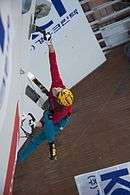 |
Figure four | Advanced climbing technique where the climber hooks a leg over the opposite arm, and then pushes down with this leg to achieve a
greater vertical reach. Requires strength and a solid handhold. | |||
| |
Figure eight | A belay device or descender shaped like an "8". | |||
| |
Figure-eight knot | A knot commonly used to secure the climber's harness to the climbing rope. | |||
 |
Finger board | Training equipment used to build finger strength. | |||
 |
First ascensionist | The person who performed the first ascent. | |||
 |
First ascent (FA) | The first successful completion of a route. | |||
 |
First free ascent (FFA) | First ascent without aid. | |||
 |
Fist jam | A type of jam using the hand. See climbing technique. | |||
 |
Fixed rope | A rope which has a fixed attachment point. Commonly used for abseiling or aid climbing. | |||
 |
Flagging | Climbing technique where a leg is held in a position to maintain balance, rather than to support weight. Often useful to prevent
barn-dooring. There are three types of flagging:
| |||
 |
Flake |
Useful when preparing a rope for coiling, or before starting a lead climb, to ensure the rope is fed cleanly and without twists. Often called "flaking out" a rope. | |||
 |
Flapper | An injury consisting of a piece of loose (flapping) skin. A climber will usually just repair these with sticky tape or super glue. | |||
 |
Flash | To successfully and cleanly complete a climbing route on the first attempt after having received beta of some
form. Also refers to an ascent of this type. For ascents on the first attempt without receiving beta see on-sight. | |||
 |
Flat-lander | Non-climber. | |||
 |
Flute | A usually insecure fin or flake of rock or ice. | |||
 |
Follow | What the second does. | |||
 |
Font | The French bouldering grading system.
foot into place, the contact with the crack being on the heel and toes. | |||
 |
Fourteener | Mountain that tops 14.000 fit (4,300 m) in the contiguous United States. | |||
 |
Free base | Climbing with your only protection being a parachute that is deployed in the event of a fall. A combination of free soloing, and
BASE jumping. | |||
 |
Free climbing |
| |||
 |
Free solo | Climbing without aid or protection. This typically means climbing without a rope. | |||
 |
French free | Also known as French climbing, or French freeing, it is the use of aid climbing techniques to bypass a section due to
climbing difficulty, rock conditions, etc.; typically for only a short section of the total climb.Stewart Green. [http://climbing.about.com/od/dictionaryofclimbing/a/FrenchFreeDef.htm "French Free Climbing"]. About.com. http://climbing.about.com/od/dictionaryofclimbing/a/FrenchFreeDef.htm. Erişim tarihi: 2009-08-14. | |||
 |
Frenchies | An exercise used to develop lock-off strength consisting of pull-ups that stop with the elbows locked at angles between 20 and 160
degrees. | |||
 |
Friable | Delicate and easily broken rock, often dangerous. | |||
 |
Friction | Climbing technique relying on the friction between the sloped rock and the sole of the shoe to support the climber's weight, as
opposed using holds or edges, cracks, etc. | |||
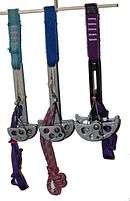 |
Wild Country firması ürünü bir çeşit yaylı takoz; Bazen her çeşit yaylı takoz için kullanılır. | Friend | A name brand of a type of spring-loaded camming device (SLCD) made by Wild Country, sometimes used to refer to any type of spring-loaded camming device. | ||
 |
Başparmak aşağıya dönük, dirsek dışarda, dirsek yönünde kuvvet kullanarak ters tırmanma tutunması. | Gaston | A climbing grip using one hand with the thumb down and elbow out, often thought of as a reverse side pull. The grip maintains friction against a hold by pressing outward toward the elbow. | ||
 |
Karabinanın dilinin düşüş sırasında kendiliğinden açılması | Gate Flutter | The action of the gate on a carabiner opening during a fall. | ||
 |
Sırtta yalnız duran ve zirve oluşturan kulemsi kaya. | Gendarme | A pinnacle or isolated rock tower frequently encountered along a ridge. | ||
 |
İpin omuz ve göğüs yerine kalçaya ve aşağıya uzanan kola sürtünmesi temelli, daha basit ama daha az kontrol sağlayan bir ipte iniş usulü. | Geneva rappel | A modified dulfersitz rappel using the hip and downhill arm for friction, rather than the chest and shoulder, offering less complexity, but less friction and less control. 'Geneva Style' is also a description used in Australia for what is commonly referred to elsewhere as 'Australian Rappelling'. | ||
 |
Buzul üzerinde hareket; yarıklara düşme tehlikesine karşı düşme durudurucu ip kullanılır. | Glacier travel | walking or climbing on a glacier; a rope is usually used to arrest falls into crevasses, but protection is not used. | ||
 |
Dikçe bir karlı yamaçtan aşağı genellikle kendi kararıyla kayarak inmek. | Glissade | A usually voluntary act of sliding down a steep slope of snow. | ||
 |
Güzergahı temizleyen bir tırmanıcının bir parçayı çıkartmayı, ya da ipi bir karabinadan kurtarmayı unutup yukarı tırmanması, böylece tepe ipini faydasız hale düşürmesi. | Golden Retriever | When a climber is cleaning a route and forgets to pull out a piece or unclip the rope and begins to climb above the piece rendering the top rope ineffective. | ||
 |
Yol çerezi, uzun güzergahlarda yemek arası yol boyu az az atıştırılan, yüksek enerji seviyesi sağlamak için yenen karışım. | Gorp | Trail mix for periodic nibbling to keep high energy level between meals on long climbs or hikes. | ||
 |
|
Grade |
| ||
 |
Alışılmadık ve zahmetli teknikler gerektiren tırmanma güzergahı | Graunchy | A route (often off-width) requiring the use of unconventional and uncomfortable techniques. | ||
 |
Geleneksel alet edavatla bir spor güzergahını tırmanma | Green Point | Climbing a sport route with the use of traditional gear. | ||
 |
Petzl firması ürünü, acemilere uygun kullanılışlı ve güvenilir bir ip freni. | Grigri | A belay device designed to be easy to use and safer for beginners because it is assisted-braking under load. Invented and manufactured by Petzl. Many experienced climbers advocate the use of an atc type device for beginners. | ||
 |
Gripped | Scared. Also over gripping the rock. | |||
 |
Kararlaştırılan güzergahtan yanlışlıkla kaya yüzeyinde çok daha zor bir yöne sapmak. Sık sık bu hatanın yapıldığı bir güzergahın adından türetilmiş terim. | Gronked | Accidentally going off-route while leading and becoming lost on a rock face in an area much more difficult than the climb being attempted. The word arises from the climb "Gronk" in Avon Gorge which is notorious for this. | ||
 |
Usulü ve tekniği yetersiz bir şekilde tırmanmak
|
Grovel | To climb with obviously poor style or technique.
| ||
 |
Tecrübesiz, bilgisiz ve ilgisiz bir tırmanıcı; öğrenme kabiliyeti yetersiz. Aşağılayıcı bir terim. | Gumby | An inexperienced, unknowledgeable and oblivious climber; is a derogatory term. Gumbies are incapable of learning. | ||
 |
Guppy | Synonym for cup, commonly used in bouldering. | |||
 |
Spor salonunda suni tırmanma duvarına idman için tırmanmak. Bazıları bunun kendi başına bir spor dalı olduğunu düşünür. | Gym climbing | Climbing indoors, on artificial climbing walls. This is typically for training but many people consider this a worthwhile activity in its own right. | ||
 |
Tırmanıla tırmanıla aşınmış, kayganlaşmış bir güzergah. | Grease ball | A route that has become climbed excessively, causing the rock to become slippery or "greasy". | ||
 |
Zorlu, çoğu kez can alıcı bir irtifa hastalığı; Beyin ödemi | HACE | High Altitude Cerebral Edema - a severe, and often fatal, form of altitude sickness. | ||
 |
Kollar önde paralel, kendini yukarı çekme | Hamster | The act of pulling oneself up with both arms parallel in front of your chest. Resembles a Hamster during feeding. That sloper required some hamstering to get to the next move. | ||
 |
Eli yarığa başparmak üstte sokup başparmağı avuca doğru çekerek eli kalınlaştırıp tutunmak, buna yüklenerek yol almak. 1940 ve 50 li yıllarda İngiltere de Joe Brown ve Don Whillans tarafından icad edilmediyse de kullanılmıştır. | Handjam | Making progress by inserting the hand (usually vertically with the thumb uppermost) into a crack and then pushing the thumb downwards towards the palm. This expands the hand and can make a highly secure placement. In the UK this move was credited with facilitating the advances in free climbing in the late 1940s and 50s made by climbers such as Joe Brown and Don Whillans although they did not invent it.' | ||
 |
Hand traverse | Traversing without any definitive footholds, i.e. smearing or heelhooking. | |||
 |
Hangdog | While lead climbing or on top rope, to hang on the rope or a piece of protection for a rest. | |||
 |
Hanging belay | Belaying at a point such that the belayer is suspended. | |||
 |
HAPE | High Altitude Pulmonary Edema — a serious form of altitude sickness. | |||
 |
Harness | A sewn nylon webbing device worn around the waist and thighs that is designed to allow a person to safely hang suspended in the air. | |||
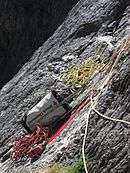 |
Haul bag | A large and often unwieldy bag into which supplies and climbing equipment may be thrown. | |||
 |
Headpoint | The practice of top-roping a hard trad route before leading it cleanly. | |||
 |
Headwall | A region at the top of a cliff or rock face that steepens dramatically. | |||
 |
Heel hook | Using the back of the heel to apply pressure to a hold, for balance or leverage; this technique requires
pulling with the heel of a foot by flexing the hamstring. This technique is notable since in most forms of climbing one uses the toes to push. | |||
 |
Heel-toe | A combination of a toe hook and heel hook. Also known as a heel-toe cam, involves using opposing pressure from the toes and heel
between two holds to hold the body on the wall. | |||
 |
Helmet | Also known as a brain bucket or skid lid. It can save your life, but only while worn. | |||
 |
Hexcentric | A protective device. It is an eccentric hexagonal nut attached to a wire loop. The nut is inserted into a
crack and it holds through counter-pressure. Often just called Hex. | |||
 |
High Ball | A tall boulder problem. Falling becomes more dangerous due to the increase in height. | |||
 |
Himalaism | Climbing grown in the Himalayas. In a broader sense this Himalayan mountaineering climbing, similar as to the nature of climbing in
the Himalayas, but also grown in other high mountains, where the height of the peaks above 7000 meters above sea level are the Karakoram, Kunlun, Hindu Kush, Pamir, Tien Shan, Daxue Shan. | |||
 |
Hold | A place to temporarily cling, grip, jam, press, or stand in the process of climbing. | |||
 |
HMS Carabiner | A round-ended carabiner for use with a Munter hitch (from the German name for the hitch; Halbmastwurfsicherung). | |||
 |
Honed | To be in peak mental and physical fitness for climbing. | |||
 |
Hook |
| |||
 |
Horn | Large, pointed protrusion of rock that can be slung. Typically also makes a good handhold. Known in the UK as a "Spike". See | |||
 |
Hueco | (Spanish hueco "hole") A climbing hold consisting of a pocket in the rock, typically round and deep and featuring a positive
lip. Huecos vary in size from accommodating a single finger (this is also called a "mono") to large enough to fit one's entire body. The term hueco entered the jargon of rock climbers from the Texas climbing area Hueco Tanks that is famous for this sort of hold. | |||
 |
Ice axe | A handy tool for safety and balance, having a pick/adze head and a spike at the opposite end of a shaft. | |||
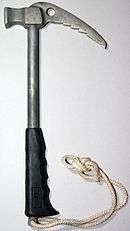 |
Ice hammer | A lightweight ice axe with a hammer/pick head on a short handle and no spike. | |||
| |
Ice piton | Long, wide, serrated piton once used for weak protection on ice. | |||
 |
Ice screw | A screw used to protect a climb over steep ice or for setting up a crevasse rescue system. The strongest and most reliable is
the modern tubular ice screw which ranges in length from 18 to 23 cm. | |||
 |
Ice tool | A specialized elaboration of the modern ice axe (and often described broadly as an ice axe or technical axe), used in ice climbing,
mostly for the more difficult configurations. | |||
 |
Indoor climbing | See gym climbing. | |||
 |
Jack Flash | Climbing something second go. | |||
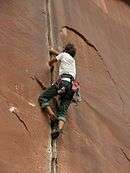 |
Jamming | Wedging a body part into a crack. | |||
 |
Jib | A particularly small foothold, usually only large enough for the big toe, sometimes relying heavily on friction to support weight. | |||
 |
Jug | A shortened term for Jug Hold, both noun and verb. | |||
 |
Jug hold | A large, easily held hold. Also known simply as a jug. | |||
 |
Jumar |
| |||
 |
Karen | See Cairn. | |||
 |
Klemheist knot | An alternative to the Prusik knot, useful when the climber is short of cord but has plenty of webbing. | |||
 |
Knee Bar or Kneebar | Involves camming your lower thigh or knee against a protruding section of rock, usually with the foot pushing against
an opposing hold. Kneebars can be very secure and are one of few ways to get a no-hand rest on overhanging rock. They also can provide additional hold on a climb.Buys, Jordan. [http://www.ukclimbing.com/articles/page.php? id=3154 "Use your knees!"]. http://www.ukclimbing.com/articles/page.php? id=3154. Erişim tarihi: 12 December 2016.Climbing, Send. "Kneebar knowledge". http://www.sendclimbing.com/pages/all-about-kneebars. Erişim tarihi: 12 December 2016. | |||
 |
Knee Drop | See Egyptian. | |||
 |
Knots | Climbers rely on many different knots for anchoring oneself to a mountain, joining two ropes together, slings for climbing up the
rope, etc. | |||
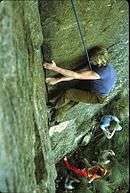 |
Laybacking or liebacking | Climbing a vertical edge by side-pulling the edge with both hands and relying on friction or very small holds for the feet. | |||
 |
Lead climbing | A form of climbing in which the climber clips the belay rope into quickdraws or similar equipment attached to the wall by means of
anchors. In traditional climbing, the climber also needs to place anchors and quickdraws. In sport climbing, the anchors are typically preplaced, and the quickdraws may either be preplaced or placed by the climber. | |||
 |
Leader Fall | A fall while lead climbing. A fall from above the climber's last piece of protection. The falling leader will fall at least
twice the distance back to his or her last piece, plus slack and rope stretch. | |||
 |
Leashless | Ice climbing with your axes not being attached to your wrist, if you drop them they're gone, but the trade off is greater mobility | |||
 |
Liquid Chalk | A liquid form of chalk with a longer hold time than normal chalk. It is used on very hard routes and competitions, where the act of
rechalking requires too much energy or time. | |||
 |
Locking carabiner | A carabiner with a locking gate, to prevent accidental release of the rope. | |||
 |
Lock-off | Using tendon strength to support weight on a handhold without tiring muscles too much. | |||
 |
Low-Angle | A face climb that is less than vertical; the opposite of an overhang or roof. The same as "slab". | |||
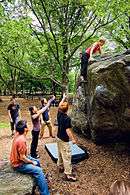 |
Mantel (abbreviation of mantelshelf) | A move used to surmount a ledge or feature in the rock in the absence of any useful holds directly above. It involves pushing down
on a ledge or feature instead of pulling oneself up. In ice climbing, manteling is done by moving the hands from the shaft to the top of the ice tool and pushing down on the head of the tool. | |||
 |
Mantle | The external covering of a climbing rope. Climbing ropes use kernmantle construction consisting of a kern
(or core) for strength and an external sheath called the mantle. | |||
 |
Match | To use one hold for two limbs. | |||
 |
Merkel | To retrieve another climbers gear because he or she is unable to or because it would be more convenient. | |||
 |
Moat | A crevasse that forms where the glacier pulls away from a rock formation. | |||
 |
Mono | (French monodoigt 'single finger') A climbing hold, typically a pocket or hueco, that only has enough room for one finger. | |||
 |
Mountain rescue | The search and rescue activities that occur in a mountainous environment, although the term sometimes also applies to search and
rescue in other wilderness environments. Also see rescue doctrine. | |||
 |
Move | Application of a specific climbing technique to progress on a climb. | |||
 |
Moving together | Method of climbing – used on easy Alpine ground – in which two or more climbers climb at the same time with running belays
between them and fixed belays not being used. Similar to simulclimbing, a technique for steeper terrain. | |||
 |
Multi-pitch climbing | Climbing on routes that are too long for a single belay rope. | |||
 |
Munter hitch | A simple hitch that is often used for belaying without a mechanical belay device. Otherwise known
as an Italian hitch or a friction hitch. | |||
 |
Névé | Permanent granular ice formed by repeated freeze-thaw cycles. | |||
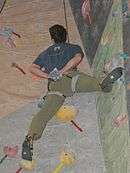 |
No-hand rest | An entirely leg-supported resting position during climbing that does not require hands on the rock. | |||
 |
Nub | A little hold that only a few fingers can grip, or the tips of the toes. | |||
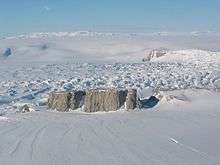 |
Nunatak | A mountain or rock that protrudes through an ice field. | |||
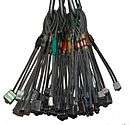 |
Nut | A metal wedge attached to a wire loop that is inserted into cracks for protection. See hexcentric. | |||
 |
Nut Key or nut tool | See Cleaning Tool. | |||
 |
Ninja feet | The quiet, deliberate, and precise placement of toes upon a foothold. | |||
 |
Objective danger | Danger in a climbing situation which comes from hazards inherent in the location of the climb, not depending on the climber's skill
level. Most often these involve falling rock or ice, or avalanches. | |||
 |
Off belay | Called by a climber when requesting that the belayer remove belay equipment from the climbing rope (for example, when cleaning top
protection from a lead route). Replied to with Belay off. | |||
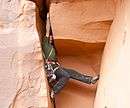 |
Off-width | A crack that is too wide for effective hand or foot jams, but is not as large as a chimney. | |||
 |
On belay | What an American climber calls when he is ready to be belayed. Replied to with Belay on. | |||
 |
On-sight | A clean ascent, with no prior practice or beta. For ascents on the first attempt with receiving beta see | |||
 |
Open book | An inside angle in the rock. See also dihedral. | |||
 |
Overhang | A section of rock or ice that is angled beyond vertical. See roof. | |||
 |
Panic Bear | A panicking novice climber clinging to handholds while searching desperately for a foothold. | |||
 |
Peak-bagging | To systematically attain designated summits under prescribed conditions. | |||
 |
Peel | To fall. | |||
 |
Peg | A piton. | |||
 |
Pendulum |
| |||
 |
Personal Anchor System (PAS) | Adjustable attachment point from climber to anchor. Allows for building anchors, cleaning routes and rappeling to be done
efficiently and faster. | |||
 |
Pickets | Long, tubular rods driven into snow to provide a quick anchor. | |||
 |
Pied à main | A movement where the foot is placed on the same hold as the hand. | |||
 |
Pied à plat | A crampon technique in the French style: to climb on high-angle ice with feet flat on the ice (as opposed to front-pointing). | |||
 |
Pied assis | A crampon technique in the French style: to rest on high-angle ice with one foot tucked under the buttocks, toes pointed straight
down-slope. | |||
 |
Pied d'Elephant | A short, light sleeping bag covering the lower half of the body only. It is designed to be used in connection with a down jacket for
lightweight bivvies. | |||
 |
Pied en canard | A crampon technique in the French style: to walk on moderate-angle ice with toes pointed outward; literally, 'duck-footed'. | |||
 |
Pied marche | A crampon technique in the French style: to walk on low-angle ice with toes pointed straight ahead. | |||
 |
Picknick stop | A No-hand rest. | |||
 |
Pinch Hold | This is a hold where you must pinch it to hold on. They come in various sizes. | |||
 |
Pinkpoint | To complete a lead climb without falling or resting on the rope (hangdogging), but with pre-placed | |||
 |
Pitch | In the strictest climbing definition, a pitch is considered one rope length 50–60 metres (160–200 ft)
. However, in guide books and route descriptions, a pitch is the portion of a climb between two belay points. | |||
 |
Piton | A flat or angled metal blade of steel which incorporates a clipping hole for a carabiner or a ring in its body. A piton is typically
used in aid-climbing and an appropriate size and shape is hammered into a thin crack in the rock and preferably removed by the last team member. | |||
 |
Piton catcher | Clip-on string fastened to piton when inserting or removing, so as to avoid loss. | |||
 |
Plunge step | An aggressive step pattern for descending on hard or steep angle snow. | |||
 |
Pof | An alternative to chalk made from pine resin. Popular in Fontainebleau but discouraged (or actively forbidden) everywhere else since
it deposits a thick, shiny resin layer on the rock and friction can only be achieved by using more pof. | |||
 |
Polish | On popular routes, the sheer passage of traffic can polish the rock to such an extent as to make the climbing much more difficult.
This is most noticeable at the crux, and more common on certain rock types. | |||
 |
Poop tube | Container for carrying out your feces during multi-day climb. The Poop Tube is made of PVC tubing, with a sealed end at the
bottom and a screw top. It has a loop attaching screw top to the body of the tube and a webbing so it can be clipped below the haul bag."Definition: Poop Tube". http://www.davidlnelson.md/ElCapitan/DefinitionPoopTube.htm. Erişim tarihi: 8 December 2016."How to Make a Poop Tube". http://www.wikihow.com/Make-a-Poop-Tube. Erişim tarihi: 8 December 2016. | |||
 |
Positive | A hold or part of a hold, having a surface facing upwards, or away from the direction it is pulled, facilitating use. Positive
hold is an opposite to a sloper. | |||
 |
Pressure Breathing | Forcefully exhaling to facilitate O2/CO2 exchange at altitude. Also called the "Whittaker wheeze". | |||
 |
Problem | Boulder problem or problem is used in bouldering to indicate the path that a climber takes in order to
complete the climb. Same as route in roped climbing. | |||
 |
Project | A potential new route or bouldering problem that is being attempted, but has not seen a first ascent yet. | |||
 |
Protection | ||||
 |
Prusik |
| |||
 |
Pseudo Leading | To climb a wall Toprope with having another rope connected to the climber, for practice of Lead climbing
clipping. The other rope is normally not connected to any belayer below and is only there to practice the
clipping. Usually practiced while learning how to Lead Climb. Also commonly referred to as "mock leading". | |||
 |
Psychological protection | A piece of protection that everyone knows will not hold a fall, but makes the climber feel better about having gear beneath them
anyhow. | |||
 |
Pumped |
climber who is pumped will find it difficult to hold on, and may struggle to lift or clip a rope.
| |||
 |
Punter | An over-ambitious and under-prepared climber. | |||
 |
Purchase | To have a solid grip on a hold or feature. "I had good purchase on that jug." | |||
 |
Quickdraw | Used to attach a freely running rope to anchors or chocks. Sometimes called quickies, draws, or
extenders. | |||
| |
Köstek | U veya C harfi şeklinde bir metalin açık kenarının vidalanmasıyla halka haline getirilen, zincirlerin uzatılması, bir şeylerin sağlamca tutturulması, asılması, eklenmesi işlerini kolaylaştırıp hızlandıran hırdavat ya da nalburiye malzemesidir | Quicklink, maillon, maillon rapide, shackle | A screw-type oval-shape stainless steel carabiner which is smaller than normal oval-shape biner, particularly used for attaching to the chains of the master anchor. Also known as a maillon, maillon rapide or shackle. | |
 |
Rack | The set of equipment carried up a climb; also, the part of a harness (consisting of several plastic loops) where equipment is hung,
ready to be used. | |||
 |
Rappel | The process by which a climber may descend on a fixed rope using a friction device. Also known as abseil or roping down. | |||
 |
RB | A removable bolt, similar in concept to a sliding nut, but shaped to fit into a drilled hole. | |||
 |
Rebolting | The replacement of bolts on an existing climb. | |||
 |
Redpoint | To complete while placing protection on a lead climb after making previous unsuccessful attempts, done without
falling or resting on the rope (hangdogging). Also see clean and pinkpoint. | |||
 |
Rest step | Energy-saving technique where unweighted (uphill) leg is rested between each forward step, sometimes by "locking" knee of rear leg. | |||
 |
Retro-bolting | The addition of bolts to an existing climb which has already been ascended using natural protection. | |||
 |
Rodeo clipping | To clip into the first piece of protection from the ground by swinging a loop of rope so that it is caught by a carabiner. This can
only be done when the first piece of gear is already placed. | |||
 |
Roof | A steep overhang which transitions sharply into shallower climbing often blocking direct sight of the feet causing the climber to
find footholds blindly. | |||
| |
Halat ya da ip | Doğal ya da yapay elyafın ya da tellerin bükülmesi ya da şerit biçiminde örülmesi yoluyla elde edilen uzun, esnek ve sağlam ip.
Halatlarda aranan başlıca özellikler büküldüğünde, burkulduğunda ya da çekildiğinde yapısının bozulmaması ve sağlamlığını korumasıdır. En önemli özelliği ise çekme dayanımıdır. Tırmanılabilir ortam veya düşmeye karşı can güvenliği için kullanılır. |
Rope | A basic item of climbing equipment that physically connects the climber to the belayer. | |
 |
Rope gun | The most capable climber in the group. The person who can get the rope up there for the rest of the party. | |||
 |
Rope jumping | Jumping from objects using rock climbing equipment. | |||
 |
Rope team | Also roped team or roped party. Team of mountaineers or climbers joined together by a safety rope. | |||
 |
Route | The path of a particular climb, or a predefined set of moves. | |||
 |
RP | A small nut, named after Roland Pauligk. Not certified for sale in Europe. | |||
 |
Runner | Made of nylon and nylon/blend materials, runners, also referred to as slings, are used by climbers for a multitude of purposes. | |||
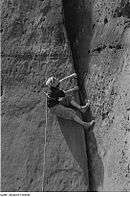 |
Runout |
frightening or dangerous. May also be used as an adjective to describe a route, or a section of a route.
| |||
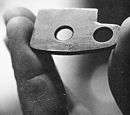 |
RURP | Acronym, stands for Realized Ultimate Reality Piton. Miniature, postage-stamp sized piton originally designed by [[Yvon
Chouinard]] | |||
 |
Saddle | A high pass between two peaks, larger than a col. | |||
 |
Sandbag | A climb which receives a much lower grade than deserved. Also used as a verb when referring to the act of describing a
climbing route as easier than it actually is. | |||
 |
Sardar or Sirdar | Head Sherpa mountain guide. | |||
 |
'scend | contraction of the word ascend, past tense: 'scended. Şablon:Crossref | |||
 |
Scheissegrippen | The intense feeling of disappointment when finding a difficult crux after a jug or good handhold. | |||
 |
Scrambling | A type of climbing somewhere between hiking and graded rock climbing. | |||
 |
Screamer |
intentionally sewn with less than maximum possible strength. The screamer is attached with carabiners between an anchor point, particularly one of dubious strength, and the climber. In the event of a fall the stitching of the sewn sections is designed to rip apart, absorbing some of the fall energy and decelerating the climber, thereby reducing the overall shock load on the dubious anchor. Screamer is a brand name of Yates Mountaineering. | |||
 |
Scree | Small, loose, broken rocks, often at the base of a cliff. Also an area or slope covered in scree. Scree is distinguished from Talus
by its smaller size and looser configuration. | |||
 |
Screw on | A small climbing hold, screwed onto the wall in climbing gyms. Can be used for feet in a route regardless of its colour. Also
referred to as a foot chip, chip or micro. | |||
 |
Second | A climber who follows the lead, or first, climber. | |||
 |
Self-Arrest | The act of planting the pick of your ice axe into the snow to arrest a fall in the event of a slip. Also a method of stopping in a
controlled glissade. | |||
 |
Self-Belay | To perform belaying for oneself. | |||
 |
Send | To cleanly complete a route. i.e. on-sight, flash, redpoint. Şablon:Crossref. | |||
 |
Serac | A large ice tower. | |||
 |
Sewing-machine leg | The involuntary vibration of one or both legs resulting from fatigue or panic. Also known as scissor leg, Elvis Presley
syndrome, or disco knee. Can often be remedied by bringing the heel of the offending leg down, changing the muscles used to support the weight of the climber | |||
 |
The end of the belay rope that is attached to the lead climber. Being on the sharp end refers to
the act of lead climbing, which is considered more psychologically demanding than top-roping or following, since it may involve more route-finding, as well as the possibility of longer, more consequential falls. | ||||
 |
Sherpa | A Sherpa is a person of the ethnic group of the same name that is located in the Himalayan Mountains. Also a generic term for
mountaineering porters in Nepal (usually those working at or above base camp) regardless of their ethnic group | |||
 |
Short fixing | A traditionally-belayed lead climber reaches a new belay station, creates an anchor, tying the lead rope off to
the anchor. The climber then switches over to self-belaying and continues to climb. Meanwhile, the second climber ascends the fixed rope using ascenders (aka Jugging) and cleans the pitch. When the second reaches the belay, he or she anchors in and starts to belay the leader in the traditional way again. When the leader reaches the next belay the process is repeated. | |||
 |
Side pull | A hold that needs to be gripped with a sideways pull towards the body. | |||
 |
Simulclimbing | A technique where both climbers move simultaneously upward with the leader placing protection which the second removes as they
advance. A device known as a Tibloc which allows the rope to only move in a single direction is sometimes used to prevent the second climber from accidentally pulling the lead climber off should the second slip. | |||
 |
Single Rope Technique (SRT) | The use of a single rope where one or both ends of the rope are attached to fixed anchor points. | |||
 |
Sit and spin | A method of starting a rappel from a cliff edge, accomplished by sitting with legs over the edge and then spinning around to face
the cliff while planting feet on the face. | |||
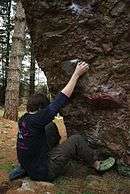 |
Sit start | Starting a climb from a position in which the climber is sitting on the floor. This is common in climbing gyms in order to fit an
extra move into the climb. Noted as SS or SDS in some topo guides. | |||
 |
Skittling | Climbing without following any specific color in a gym with color-designated routes/problems. Also referred to as "climbing the
rainbow," since any and all colors of holds are used. | |||
 |
Skyhook | A small hook which gives hold on small protrusions on watery and slippery grips. They are most often used for placements, often
extremely marginal, in aid climbing, although they also feature in some extreme free routes. Additionally, the skyhook can be attached to the harness, thus allowing the climber to rest, or held in one or both hands to hold a grip. | |||
 |
Slab | A relatively low-angle (significantly less than vertical) section of rock, usually with few large features. Requires slab climbing
techniques. | |||
| |
Slab climbing | A particular type of rock climbing, and its associated techniques, involved in climbing rock that is less than vertical. The
emphasis is on balance, footwork, and making use of very small features or rough spots on the rock for friction. | |||
 |
Slack | Portion of rope that is not taut, preferably minimized during belay. | |||
 |
SLCD | Abbreviation for spring-loaded camming device, a type of protection device. These are better known by
the term cam. | |||
 |
Sling | Webbing sewn, or tied, into a loop. | |||
 |
Sloppy Plopping | Poor footwork [Northumberland climbing slang] as in "nae sloppy ploppin'", i.e. 'you'll need accurate footwork to have any chance of
flashing this'. | |||
| |
Sloper | A sloping hold with very little positive surface. A sloper is comparable to palming a basketball. | |||
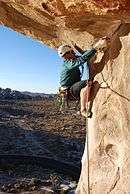 |
Smearing | To use friction on the sole of the climbing shoe, in the absence of any useful footholds. | |||
 |
Smedging | Smearing on an edge, especially on a dime edge or any linear hold that is too small to stand on or use as an ordinary positive
hold. | |||
 |
Snarg | A type of tubular ice screw that is inserted by hammering. | |||
 |
Snow fluke | An angled aluminium plate attached to a metal cable. The fluke is buried into snow, typically used as a deadman anchor. | |||
 |
Solo climbing | Setting and cleaning one's own protection on an ascent; climbing by oneself. | |||
 |
Soupy | A hold that is wet and slimy from water or some other source. | |||
 |
Spinner | In indoor climbing, a hold that is not secure and spins in place when weight is applied. | |||
 |
Spike | Şablon:Crossref | |||
 |
Splitter | Describes a clean crack with perfectly parallel sides, usually in an otherwise blank face. Generalized to refer to any great climb,
happy situation, or even favorable weather. | |||
 |
Sport climbing | A style of climbing where form, technical (or gymnastic) ability and strength are more emphasized over exploration, self-reliance
and the exhilaration of the inherent dangers involved in the sport. Sport climbing routes tend to be well protected with pre-placed bolt-anchors and lends itself well to competitive climbing. | |||
 |
Spotting | A method of protection commonly used during bouldering or before the leader has placed a piece of protection. The
spotter stands beneath the climber, ready to absorb the energy of a fall and direct him away from any hazards. | |||
 |
Sprag | A type of hand position where the fingers and thumb are opposed. | |||
 |
Spraying | Giving unwanted — and unasked-for - beta to a fellow climber. Also, excessive, overly prominent, or boorish proclamation
of one's own (often exaggerated) skills or exploits. | |||
 |
Static | Of a style of climbing or specific move, not dynamic. In general this entails movement of a limb to a new hold without the simultaneous transfer of weight. Instead weight transfer occurs after the limb has moved. | |||
 |
Static rope | A non-elastic rope. Compare with dynamic rope. | |||
 |
Steep | Descriptive of any climbing face that is angled beyond vertical. Şablon:Crossref. | |||
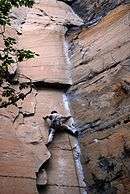 |
Step cutting | Scooping steps out of snow or ice with the adze of an ice axe. | |||
 |
Step kicking | Scooping and stamping steps out of soft snow with the feet. | |||
 |
Sticht plate | A belay device consisting of a flat plate with a pair of slots. Named after the inventor Fritz Sticht. | |||
 |
Stick clip | A long stick or extendable pole on the end of which a climber can affix a quickdraw. It allows the climber to clip a quickdraw to
the first bolt on a sport climb while still standing on the ground. This is especially useful if the first bolt is high up, and out of the comfort zone of the climber. A stick clip can be bought, easily made or even improvised when needed. Ethically controversial in some communities. | |||
 |
Stopper |
| |||
 |
Summit |
| |||
 |
Swami Belt | A kind of proto-climbing harness consisting of a long length of tubular webbing wrapped several times around the climbers body
and secured with a water knot. Largely eschewed today in favor of commercial harnesses. | |||
 |
Sweeper | Refers to the last member or the tail of a climbing group. The sweeper's task is to spot and retrieve things that may have
accidentally fallen from the preceding climbers; to make sure that no mess or gear is left behind; and to make sure that the rear is keeping up with the whole team. The term sweeper, a Filipino contribution to mountaineering vocabulary, was introduced in 1998 and was inspired by the Cleaner, a character in the 1990 film Nikita (also known as La Femme Nikita) by Luc Besson. | |||
 |
Swinging-lieback | A dynamic form of the lieback, described above, rotating off one foot while maintaining a grip with one hand, then
grabbing a high handhold at the deadpoint of the swing with the other hand. This move is frequently reversible, unlike more aerial dynos. | |||
 |
Switcharoo | To swap limbs on a particular hold. Not to be confused with matching. | |||
 |
Take | Called by a climber when requesting that the belayer remove all slack. See hang dogging. | |||
 |
Talus | An area of large rock fragments on a mountainside that may vary from house-size to as small as a small backpack. The area, if older
and consolidated, may be stable, or the rocks may be precariously balanced. Talus is distinguished from scree in that it is larger and may feature solid interlocking of the rocks, while scree is by definition loose. | |||
 |
Teabagging | When, after a whipper, or long fall, a climber falls past their belayer, who is generally lifted up off the ground. | |||
 |
Technical climbing | Climbing involving a rope and some means of protection, as opposed to scrambling or
creativity required to protect a route. Difficulty ratings of climbs often is a combination of technicality of a climb and the endurance or strength necessary to complete it.
the hand is open. The relative angle between the finger bones is gradual. The load applied is coming from tension in the forearm muscles. | |||
 |
Tension | A technique for maintaining balance using a taut rope through a point of protection. | |||
 |
Testpiece | A climb that is representative of the hardest, best climbs in an area. | |||
 |
Thrutching | Make progress by squeezing into a space and wriggling against opposing rock surfaces. | |||
 |
Tie-In Points | The leg straps and waist belt create two loops connecting the belay loop. The points which you tie in at. Also known as soft
loops. | |||
| |
Top rope | To belay from a fixed anchor point above the climb. Top-roping requires easy access to the top of the climb,
by means of a footpath or scrambling. | |||
 |
Top-out | To complete a route by ascending over the top of the structure being climbed. | |||
 |
Track | To use holds specified out for you in any route, usually used in gym climbing. | |||
 |
Traditional climbing | A style of climbing that emphasizes the adventure and exploratory nature of climbing. While sport climbers generally will use pre-
placed protection ("bolts"), traditional (or "trad") climbers will place their own protection as they climb, generally carried with them on a rack. | |||
 |
Training | Getting prepared to climb on difficult mountains. | |||
 |
Tramming | A technique that is typically used while lowering and cleaning gear from an overhanging and/or traversing route. A
quickdraw is clipped between the climber's harness and the rope that is threaded through the gear. As the climber is lowered by the belayer, the quickdraw holds the cleaner close to the wall and following the line of the route. Without the quickdraw, the climber would lower straight down, further and further from the remaining gear to be cleaned. Also known as trolleying. | |||
 |
Traverse |
| |||
 |
Tricam | A simple camming protection device that has no moving parts. | |||
 |
Tuber | A belay device. | |||
 |
Tufa | A limestone rib formation that protrudes from the wall which can sometimes fit within the pinching grasp of a climber's hand;
alternatively: a plastic, bolted on bouldering hold designed to replicate such a formation on an indoor climbing wall. | |||
 |
Twin Ropes | System where the climber is using two thin ropes instead of one thicker one, but unlike double ropes twin ropes
have to be clipped through the same biner for each piece of protection. Twin ropes are often used by trad and alpine climbers. They allow full pitch repelling and help reducing the chances for accidental cutting of the rope by sharp rock edges. | |||
 |
Two man stand | An outdated climbing technique where one climber stands on the shoulders of another climber as an assist in climbing. | |||
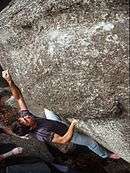 |
Undercling | A hold which is gripped with the palm of the hand facing upwards | |||
 |
Übergrippen |
| |||
 |
"V"-grade | A technical grading system for bouldering problems, invented by John Sherman. | |||
 |
V-thread | A type of abseiling point used especially in winter and ice climbing. Also called abalakov thread. | |||
 |
Verglas | A thin coating of ice that forms over rocks when rainfall or melting snow freezes on rock. Hard to climb on as there is insufficient
depth for crampons to have reliable penetration. See also clear ice and glaze ice. | |||
 |
Volume | A large, hollow bolted-on bouldering hold. | |||
 |
WAD | Originating in Sheffield, a WAD is a "super climber" or climber who is on-sighting 7c+. | |||
 |
Wand | A bamboo stick with a small flag on top used to mark paths over glaciers and snow fields. | |||
 |
Wallerina | A graceful female climber who appears to dance up the climbing wall. | |||
| |
Webbing | Hollow and flat nylon strip, mainly used to make slings. | |||
 |
Webolette | A piece of webbing with eyes sewn into the ends which can be used in place of a cordelette. | |||
 |
Weighting | As in, "weighting the rope." Any time the rope takes the weight of the climber. This can happen during a minor fall, a whipper
(long fall), or simply by resting while hanging on the belay rope (see also hangdogging). | |||
 |
Whipper | A lead fall from above and to the side of the last clip, whipping oneself downwards and in an arc. Has come to denote any fall
beyond the last placed or clipped piece of protection. | |||
 |
Wired | A route or sequence that a climber has rehearsed extensively and thus ascends with ease. See dialled. | |||
 |
Wires | See nuts. | |||
 |
Wolf moon | To complete a lead climb during night time. | |||
 |
Woodie | A home made climbing wall. Often specifically a hybrid between a climbing wall and a fingerboard. Specifically
called such because of the wooden panels (usually left unpainted) used to attach the climbing holds to. | |||
 |
X (Protection Rating) | A rating from the Yosemite Decimal System given to climbs that have very poor or no protection. These climbs often present risk
of serious injury or death if a fall were to occur, even if the climb is properly protected. | |||
 |
Xeno | A hold appearing to be composed of a different type of rock than the surrounding face. | |||
 |
Yabo | Another name for a Sit start, a 'Yabo start' was named after John 'Yabo' Yablonski.Carl
Ockier. "The climbing dictionary". http://home.tiscalinet.de/ockier/climbing_dict.htm#yabo. Erişim tarihi: 2007-02-20. | |||
 |
Yard up | To pull on the rope to make upward progress, often with assistance from the belayer. This may be done to bypass a crux, or to
quickly regain ground lost after a fall without re-climbing the section. AKA to "jug up" the rope. | |||
 |
Yosemite Decimal System | A numerical system for rating the difficulty of walks, hikes, and climbs in the United States. The rock climbing (5.x) portion of
the scale is the most common climb grading system used in the US. The scale starts with the easiest grades at 5.0 and is open-ended on the harder end. (Kasım 2013 itibarıyla), the most difficult grade was 5.15c. | |||
 |
Z-clipping | Clipping into a piece of protection with the segment of rope from beneath the previous piece of protection,
resulting in a potentially dangerous tangled configuration of the belay rope. If not fixed can result in high drag. | |||
 |
Zipper fall | A fall in which each piece of protection fails in turn. In some cases when the rope comes taut during a
fall, the protection can fail from the bottom up, especially if the first piece was not placed to account for outward and/or upward force. | |||
 |
Z-pulley | Also Z-system. A particular configuration of rope, anchors, and pulleys typically used to extricate a climber after falling
into a crevasse. | |||
Ayrıca bakınız
kaynakca
- ↑ "Rock Climbing Dictionary". Rock Climbing.com. http://www.rockclimbing.com/Articles/Introduction_to_Climbing/Climbing_Dictionary_528.html. Erişim tarihi: 2012-10-28.